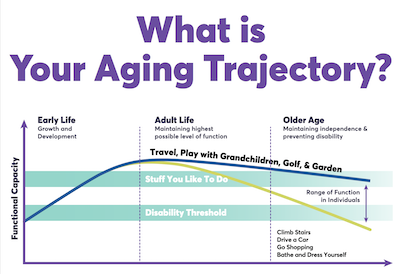
We say often that mature clients need fitness, but that doesn’t mean they want fitness. If we are really honest, dozens of things sound more interesting and enticing for people.
So how do we make our fitness programs attractive to prospective clients? I am convinced that if you focus more on selling the blue line, which marks the line of functional longevity and functional independence, you will be selling something that most people want. We as fitness professionals need to communicate that our fitness programs are really about training for the life your client wants — the life she dreams of — not just about fitness.
We at Functional Aging Institue (FAI) have defined what we believe are four cornerstones of the aging process and how people’s goals, desires, likes and even dreams change every decade. Here are the 4 Cornerstones:
- An in-depth understanding of the aging process and its implications for exercise
- A recognition of the desires, goals and aspirations that accompany the third age
- A strong belief that people can be fit, healthy, vibrant and functional at any age
- An approach to exercise which is grounded in evidence and honed with experience
Let me share an example with you. I had a client named Joan (pictured); she came to us at 80 years old, not fit, deconditioned and with Parkinson’s disease. Joan wasn’t looking for a fitness protocol or a gym, but what she wanted was to travel to the Galapagos Islands. She knew she needed to be stronger, more functional, and have better aerobic endurance to accomplish her goal, and after training for a year, Joan did just that!
Or let me introduce you to Don. He called himself “the tottering ole grandfather” and was 88 years old. He realized his days of traveling from Indianapolis to Seattle to visit his four grandchildren were coming to an end unless he could get more strength, balance, and physical capacity for those trips.
Two years later at 90 years young, Don wrote us a two-page letter describing how we had completely changed his outlook on his nineties. He saw his first grandchild graduate high school and fully expected to be present for all their graduations. Don is a fun friend to have on Facebook!
Here are a few tips on how to ensure your clients can reach their dreams and goals like Joan and Don:
1. Focus on functional tasks your clients need to do on a daily or weekly basis and sprinkle in some functional tasks they have to do for their big trips coming up. For example, movements could include tasks like carrying groceries, luggage, laundry or household items; picking up items; climbing stairs; putting something on a shelf; or looking under the couch for the darn remote. Lifting luggage, pushing and pulling luggage and navigating busy crowded airports and uneven terrain are also excellent tasks.
2. Focus on balance challenges your client might face on a weekly or monthly basis: navigating a parking lot, stops, starts, turns, stepping over a parking block, stepping up or down a curb, and changing terrains from grass to dirt to pavement. Tasks inside could include stairs at home, stepping over pets, changing flooring from hardwood to carpet, or catching your foot on something.
3. Think about what your client can do and how to accomplish what they dream to do. Focus on strengths and abilities, not just limitations. Design your sessions for success.
4. Remember to think about all 6 domains of human function from the Functional Aging Training Model: Musculoskeletal, Cardiovascular, Balance, Mobility, NeuroMuscular and Cognitive/Emotional. As you train clients and focus on what they need, want and dream to do, you will find it is less about fitness and more about changing lives. Instead of before and after pictures, your testimonials become amazing life-changing adventures.








![dual-task]](https://cms-static.wehaacdn.com/fit--pro-com/images/dual-task-.5494.widea.0.jpg)











